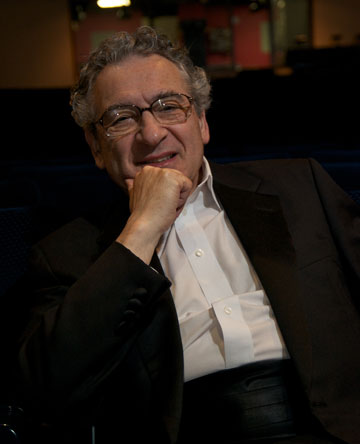Elgin Symphony closes season colorfully with “Scheherazade”

The Elgin Symphony Orchestra, already one of the region’s finest ensembles, is on the search for a new music director and that brings an extra dose of excitement and variety to the final programs of their 62nd season.
Long-time director Robert Hanson officially stepped down last year, opening the floodgates to over a dozen contenders who have been serving up their best efforts in hopes of taking the helm in 2013.
This weekend’s conductor was Victor Yampolsky, notable veteran of Northwestern University’s Music School among many other institutions. With his Russian pedigree, it comes as no surprise that he triumphed in the always-challenging Scheherazade, Rimsky-Korsakov’s most popular and scintillating score, which showed off many of the orchestra’s strengths, notably in the pungent solos and massed ensembles.
While the acoustic of their home, the venerable Hemmens Theater in Elgin, is on the edgy side of dry, the orchestra amply filled the space and for the most part balances were preserved and details cleanly delineated.
The quality of playing was on display in the first piece of the evening, Cesar Franck’s uncharacteristically pictorial symphonic poem Le Chasseur Maudit of 1882, deriving, as so many of the period’s tone paintings do, from the pioneering examples of Liszt and Berlioz. This piece is atmospheric and dynamic with multitudes of horn-calls and misty landscaping as setting for the drama of the impious hunter who chose to ride to the chase on Sunday rather than attend church. With its eerie Gothic shivers and the pounding hoofbeats of the frightened horseman which recall Liszt’s Mazeppa, this brief drama is a much-too-neglected orchestral showpiece which began unevenly yet was brought off brilliantly by the coda.
Matt Haimovitz was the soloist in Saint-Saens’ concise and virtuosic First Cello Concerto. The French composer’s concerto almost qualifies as a tone poem in its own right with its three tied-together but contrasting movements opening with over-heated triplets leading to lyrical patches interrupted by a coolly classical minuet section before returning to the opening themes and closing dramatically and virtuosically.
Haimovitz was fluent in the romantic and overtly classical sections of the work but seemed rather understated in the more dramatic parts with the orchestral balance just slightly overwhelming at times.
The climax of the evening was the rousing performance given to Scheherazade, showcasing a wealth of excellent orchestral soloists and some powerful ensemble playing. Notable from the start was the contribution of concertmaster Isabella Lippi, in the role of the storytelling princess who shone in her collaborations with harpist Stephen Hartman and throughout the work.
The music doesn’t really have a program as such, though the scene painting is vivid and atmospheric. The four-movement suite offers many orchestral delights and challenges: the first section with its beefy opening chords and sea-inflected rocking; the second movement with its fluid dance rhythms interrupted by a very dramatic scene delineated by tremulous strings and aggressive brass punctuations.
The third movement introduces a lush romantic melody which was explored by the excellent string section and succeeded by a jaunty march with the violin and harp uniting again and joined later by the pristine flute playing of Jean Bishop. The last movement again showcases the violin with vigorous double-stopping matched by some flashy trumpet and woodwind work leading to a brilliant romantically tinged pile up. The conclusion of the work was announced by a silvery violin solo as Scheherazade slips into bed with her tyrannical lover.
Yampolsky got the best out of the talented Elgin ensemble with only a few passing smudges and occasional longeurs. The orchestra’s efforts won them a rousing standing ovation from the over 1,000-strong audience.
Posted in Performances




